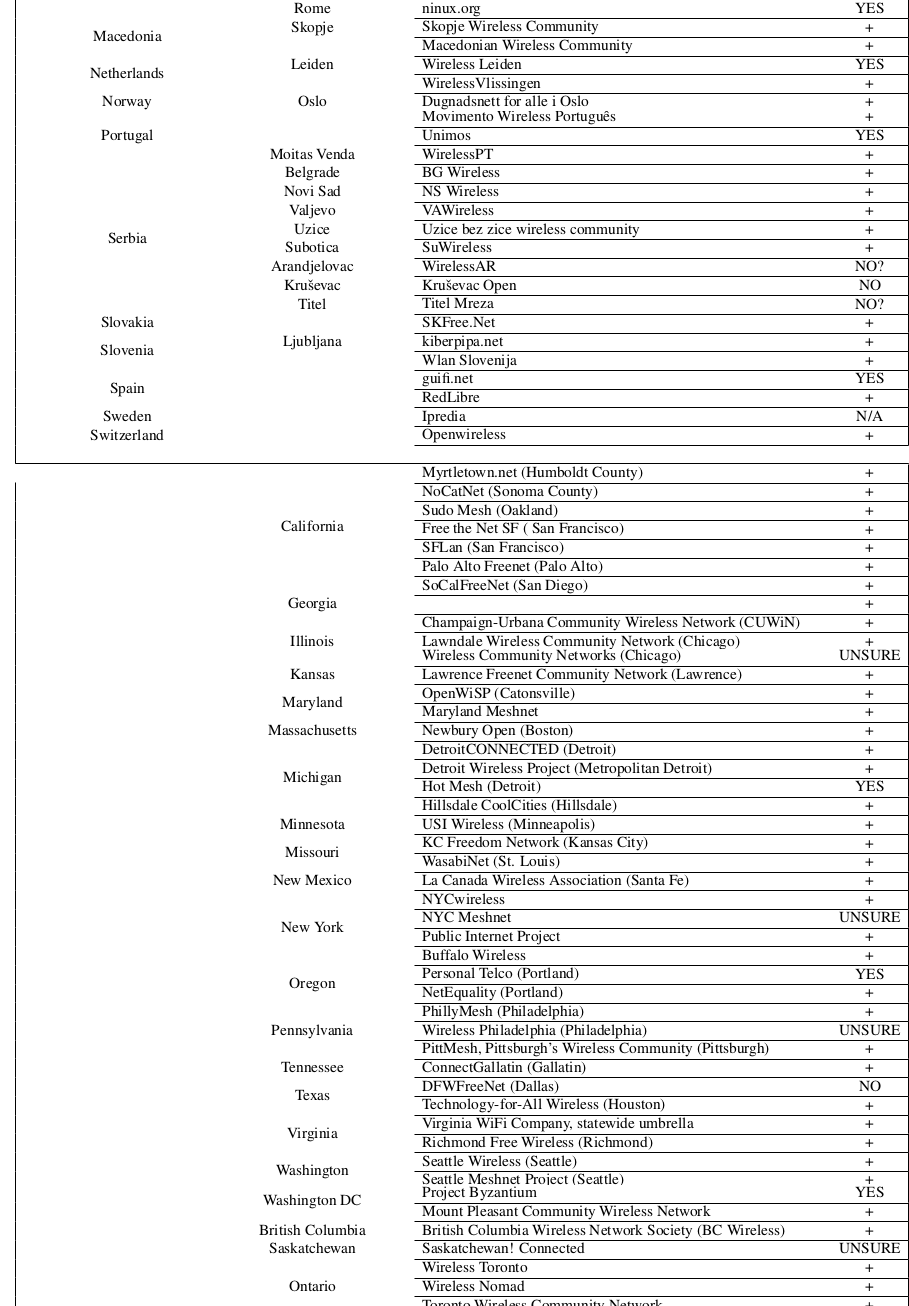- Seattle Wireless (WA, USA)
- NoCat (Sebastopol, CA, USA)
- NYCwireless (NY, USA)
- Champaign-Urbana Community Wireless Network (IL, USA)
- Personal Telco Project (Portland, OR, USA)
- Athens Wireless Metropolitan Network (Greece)
- Freifunk (Germany)
- FunkFeuer (Austria)
- Ninux (Italy)
- Wireless Leiden (Netherlands)
- Village Telco (Johannesburg, South Africa)
- Nepal Wireless Networking Project
- Melbourne Wireless (Australia)
- Guifi (Catalonia)
- Rhizomatica (Mexico)
- Federation French Data Network (FFDN)
- wlan-slovenija (Slovenia)
- Sarantoporo.gr (Greece)
- AlterMundi (Argentina)
- Network Bogota (Colombia)
- WirelessPT (Portugal)
- Red Hook WiFi (Brooklyn, NY, USA)
- Detroit Community Technolgy Project (USA)
- NYCmesh (USA)
- MetaMesh → PittMesh (Pittsburgh, USA)
- Sudo Mesh → People’s Open Network (Oakland, USA)
- TOmesh (Toronto, Canada)
- PhillyMesh (Philadelphia, USA)
- MassMeshTech (Boston, USA)
- OlyMesh (Olympia, USA)
- OpenFreeNet (India)
- Coolab (Brazil)
- Cooperative governing body, legal entity for network
- Member collectives/companies provide services
- Maintained by volunteers and professionals
- Shared belief in the commons
- Examples: Guifi, Federation French Data Network (FFDN)
- Started in early 2000s
- Federated under Guifi Foundation in 2008
- 26 companies provide services on the network
- Currently over 32,000 active nodes
- Mostly located in Catalonia [[3]]
- Loose associations of small networks
- Unifying principles, technologies
- Rooted in hacker/hobbyist communities
- Fully flat, volunteer organized
- Value peer-production over ideology of the commons
- Examples: Freifunk, Funkfeuer, Ninux
- Began in 2002
- Developers of batman-adv, enables Layer 2 routing
- More than 400 communities
- largest include,
Muenster (>4000 nodes)
Aachen (2000)
Munich (1657)
Stuttgart (1335) [[3]]
- First public node in 2014
- 185 active nodes
- Non-profit project of Internet Society (ISOC-NY)
- Operate two 'supernodes' in Manhattan and Brooklyn
- Began in 2013
- 67 active nodes
- Volunteer project under auspices of MetaMesh
- Donated time, to gain experience
- Compensated for-profit work, subsidizes non-profit efforts
- started in 2012 with stimulus funding
- collaboration of Allied Media, Open Technology Institute
- spawned...
Equitable Internet Initiative (EII)
CassCo WiFi
Digital Stewards Training
- Inspired by DCTP
- 15 active nodes in Brooklyn, NY
- No longer holding regular meetings
- Trouble maintaining Digital Stewards training
Examples: Street Net (Cuba), Network Bogota, AlterMundi
- Used almost exclusively for gaming in Cuba
- Enitrely illegal, informally permitted to operate
- Zero porn, politics, or links to larger internet
- When all else fails, there's El Paquete! [[4]]
- Started in 2012
- Grassroots organization
- Bottom-up approach to deal with communal problems
- Most members belong to QuintanaLibre CN, in Cordoba
- Developers of LibreMesh firmware
- community involvement
- sustainability
- training
- use
- robustness
in that order
- have fun
- community involvement
- sustainability
- training
- use
- robustness
in that order
[[1]] THE END OF CFN, cfn.tangledhelix.com [1]: http://cfn.tangledhelix.com/end_announce.html
[[2]] Navarro et. al, Report on Existing Community Networks and their Organization, netCommons [2]: https://www.netcommons.eu/sites/default/files/
[[3]] "What is guifi.net," guifi.net [3]: https://guifi.net/en/what_is_guifinet
[[4]] "Community finden", freifunk.net [4]: https://freifunk.net/wie-mache-ich-mit/community-finden/
[[5]] Martinez, Antonio Garcia, "Inside Cuba’s D.I.Y. Internet Revolution", Wired [5]: https://www.wired.com/2017/07/inside-cubas-diy-internet-revolution/
















